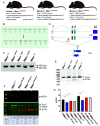A mouse model of MEPAN demonstrates a role for mitochondrial fatty acid synthesis in iron-sulfur cluster and supercomplex formation
- PMID: 41021813
- PMCID: PMC12519216
- DOI: 10.1073/pnas.2506761122
A mouse model of MEPAN demonstrates a role for mitochondrial fatty acid synthesis in iron-sulfur cluster and supercomplex formation
Abstract
MEPAN (
Keywords: genetics; iron; mitochondrial disease; mitochondrial fatty acid synthesis; mouse model.
Conflict of interest statement
Competing interests statement:D.C.W. is on the scientific advisory board of Pano Therapeutics, Inc. and Medical Excellence Capital.
Figures






References
-
- Heimer G., Gregory A., Hogarth P., Hayflick S., Ben Zeev B., MECR-Related neurologic disorder. GeneReviews 31070877 (1993). - PubMed
-
- Jia N., et al. , Recurrent MECR R258W causes adult-onset optic atrophy: A case report. Eur. J. Med. Genet. 68, 104917 (2024). - PubMed
-
- Gorukmez O., Gorukmez O., Havali C., Novel MECR mutation in childhood-onset dystonia, optic atrophy, and basal ganglia signal abnormalities. Neuropediatrics 50, 336–337 (2019). - PubMed
MeSH terms
Substances
Grants and funding
LinkOut - more resources
Full Text Sources

